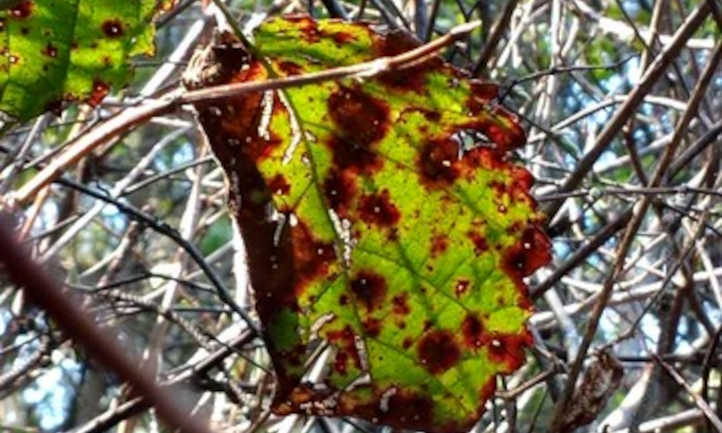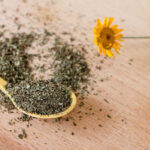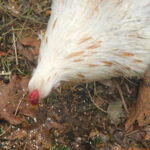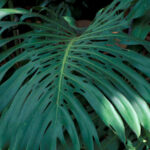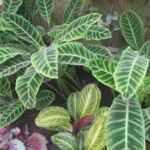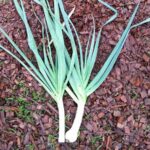A brown spot on a leaf could have so many causes. A disease could occur, or it could be a condition that changes the appearance of your plant. It could stem from one particular issue, or it could be a combination of problems that cause your plant to develop brown spot symptoms and lesions. It could also be a seed-bourne illness.
Some of the discoloration you see could be a very minimal problem that’s easy to remedy. Some of the observed dark spots could be related to a serious disease that needs to be taken care of as soon as possible. Because there are so many reasons for brown spots, it’s important to identify the problem and act.
So here, we’ll run down a list of reasons for brown spot problems on a plant. This is by no means an exhaustive list, but it does cover many of the most common problems that cause brown spots and lesions. Use this list to determine what is going on, and how to remedy the issue.
So, You Have Brown Spots. Now What?
Most likely, your plant is in conditions that need to be adjusted to eliminate brown spots and the potential for future ones. If there is a disease present, many can be eliminated. There are a few that can’t be treated, and they need to be identified quickly so a pathogen doesn’t spread to another plant.
Most crops won’t contract incurable diseases if they have what they need from the start. Sometimes you don’t have control over that – for instance, if you purchased a plant or inherited it – but look at the issue as an opportunity to learn and apply that knowledge in the future. If you do have the ability, give each plant the best possible conditions to grow in, and they’ll have adequate resistance to deal with common pests and diseases.
Diseases That Cause Brown Spot
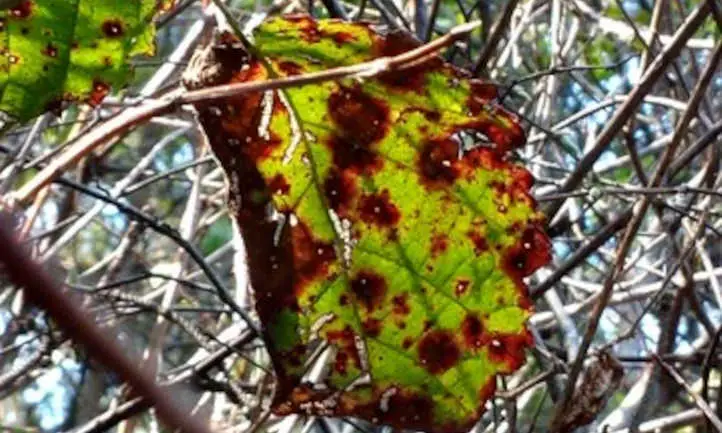
The vast majority of brown spot cases originate in pathogenic infections of some kind. Here, we’ll discuss the most common fungal, bacterial, oomycete, and viral diseases that cause brown spot. We’ll include how to act once you’ve identified the problem.
Fungal Diseases
While we often work with beneficial fungi in our gardening practice, some are not so beneficial. Septoria leaf spot is caused by the fungus Septoria. The species varies depending on which particular plant hosts the fungus. The first signs of a septoria brown spot infection occur on the lower leaves of the plant. Septoria brown spot is often spread by infected insects, wind, water, human touch, or infected gardening tools. The septoria brown spot pathogen infects tomatoes, pistachio, cucurbits, and many other types of foliage. On nightshades, it begins with wet lesions that are small and grow to ¼ inch over time. Then as the disease progresses the spots turn from brownish to white as spores develop and a fungal conidia forms. On other plants, the first symptoms of septoria brown spot are blotchy dark reddish-brown spots on leaves that tend to be focused at the midvein. To treat the disease, remove any damaged leaves and fallen leaves below the plant. Sanitize your tools and destroy septoria brown spot infected plant matter. Then use either copper fungicidal sprays or Bacillus subtilis based bacterial fungicidal sprays, applied in intervals of 7 to 10 business days. All this should work to eliminate septoria brown spot.
Specific to pine trees is pine brown spot, caused by the fungal pathogen Mycosphaerella dearnessii also known as Scirrhia acicola. The first symptoms are brown spots on pine needles which spread to create brown patches in the tree overall. As it progresses, dark black spores poke through the needles, ready to spread elsewhere. In fall, needles turn reddish-brown and fall off the tree. Infections are most common on the lower branches of pine trees, and it’s most severe when there are long, warm, wet summers. To prevent the disease, ensure there is adequate space and air circulation between pine trees. Prune off the bottom-most branches, and mulch under the trees. Don’t irrigate with sprinkler systems, and only prune during dry winter weather. Treat the fungus with copper sulfate or chlorothalonil-based fungicidal spray when the needles are half-grown back. Remove all pine debris below trees if necessary and destroy infected debris.
Venturia spp. cause fungal leaf and shoot blight in aspen trees, especially in particularly wet spring seasons. It shows itself on new aspen leaves in May, which take on brown spots which cause leaf deformity. New shoots bend over in the shape of a shepherd’s crook. As the leaves mature, the tree becomes more resistant to the disease. However, the pathogen overwinters in shoots and can attack again the following spring. Consistent infection can weaken the tree and leave it open to pests and other disease pathogens. In trees over 15 feet, the problem doesn’t usually persist. In young trees under 10 feet, prune damaged branches in dry weather, and destroy infected twigs and shoots. While fungicidal sprays are often a treatment option, here they haven’t shown enough efficacy for us to recommend them.
Rust fungi have over 7000 species and hosts in the plant world, with soybean being a common host. Most of the rust diseases gardeners deal with come from the genera Puccinia, Uromyces, Gymnosporangium, and Cronartium. The brown-colored rust is a symptom of spores waiting to mature and spread to other leaf matter. As they remain on plant matter, they parasitize the leaf and stem tissue, producing another round of spores that move to other leaves. Indications you’re dealing with rust show in summer through fall. The first signs are orange, red, yellow, or brown pustules or circular spots, on the leaves and stems. Sometimes they are present on flowers and fruit. Leaves may also fall prematurely. Planting rust-resistant varieties prevents its proliferation in your garden. Providing enough space for good air circulation works well too. As the season begins, apply copper fungicides in 7-10 day intervals at least 5 times. This also prevents rust.
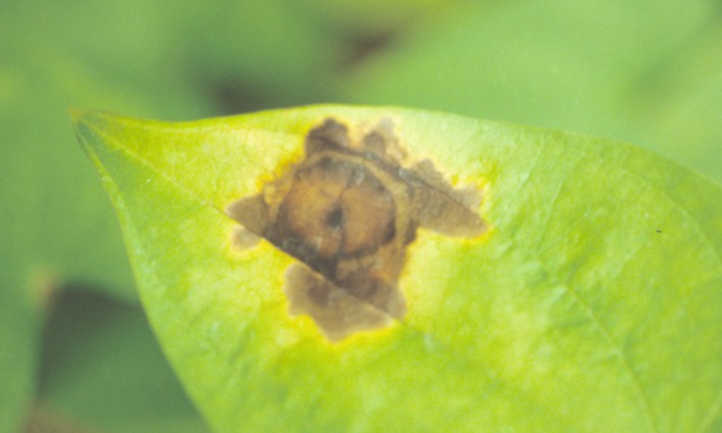
Anthracnose is another common fungal disease that causes brown spot on leaves and fruit. Soybean is commonly infected What distinguishes it from others we’ve talked about up to this point is it begins with one large brown spot that spreads across the surface of broad leaves. On corn, the discoloration and lesions are banded and streaky. The streaks or spots widen and can cause blackened leaves in spring and early summer. Usually, anthracnose chills out as the weather warms. But if the symptoms are left unchecked the problem can move to fruit. Neem oil is an excellent treatment for anthracnose. Copper fungicides and sulfur fungicides also help treat the issue. Dip harvested fruits in hot water to eliminate any remaining fungi.
Alternaria leaf spot is initiated by fungi in the Alternaria genus, commonly affecting soybean. It begins on broad leaves as dark brown spots proliferate across the tissue, sometimes developing a yellow ring. Damaged leaves will wilt as dark spots move across their surface. The fungi will sporify on fruit as well in the form of black patches if infected leaves aren’t dealt with. Most gardeners deal with about 13 species of alternaria. Leftover crop residue is sometimes the culprit for the continuation of the fungi. As soon as brown spot lesions show themselves, gardeners should treat leaves with copper fungicides and sulfur fungicides. Prevent the disease by clearing crop residue at the end of the growing season. Grow disease-free seed, and use drip irrigation that keeps water off leaves. Give your veggies and fruits enough space for good air circulation.
Brown patch disease comes from a Rhizoctonia fungus. Related to rust, this brown spot forms on lawn turf. It occurs in the warm mid to late summer, when the weather is hot and humid. The first signs are circular or oblong patterns of light-yellow discoloration that occur in the grass. It continues to move outward leaving small patches of green in the center of each patch. Since it will occur in the growing season, often the first appearance of symptoms is a sign that it’s already well on its way, especially in soybean crops. But this is when you want to treat it. Don’t mow or walk on infected areas at this time because the pathogen survives in the yellow patches. Instead, treat them with fungicidal sprays. Wait to fertilize until the disease is no longer affecting your lawn.
Bacterial Diseases
Bacterial brown spot – developed through infection by the bacterial pathogen Psuedomonas syringae – can develop on leaves and fruit. Soybean is commonly affected. It begins as a yellow spot that begins to brown as it progresses. At this time the margin of the spot is surrounded by a yellow margin, especially on legumes like soybean. The bacteria often overwinter in weeds. Planting varieties that have shown resistance to infections is a prevention method. Treat seeds with fungicides before planting. Till under infected specimens deeply into the soil. Then allow the soil with existing tillage to solarize for at least 2 months before planting again. Fungicides can treat the disease as well when applied consistently in applications at 7 to 10-day intervals.
Common bacterial blight causes brown lesions that are water-soaked and eventually become necrotic. It commonly affects soybean. They often have an irregular shape and yellow margins. On soybean, the bacterial pathogen creates reddish-brown lesions. Xanthomonas axonopodis pv. is the species of bacteria that causes blight symptoms, though they vary greatly from crop to crop. It is often transferred by infected seeds. It also overwinters in weeds spreading to crops in the wind and water. Treat seeds with fungicidal sprays before planting. Unfortunately, there is not much you can do when the infection sets in as there are no treatments.
Halo blight gets its name from water-soaked brown spot lesions that have yellow halos, showing the first signs of infection. It is most common in beans, particularly soybean. The lesions appear on a leaf after it has come in contact with infected crop residue, or when it grows from infected seeds. Infected leaves then get worse in cool, wet seasons. Manage brown spot from this blight in the same way you would common bacterial blight. The lesions can progress to a point where new growth isn’t possible, and leaflets die off before they can develop.

Oomycete Diseases
Damping-off originating with Pythium and Phytophthora water molds causes dark brown spots at the base of seedlings. It occurs in seed-starting in media that isn’t well-draining or remains wet for too long. There are two types of damping-off: pre-emergent which affects yet-to-sprout seeds; and post-emergent which causes seedlings to suddenly wilt and form a dark brown spot at the base of the stem. Too much shade and warm weather can cause conditions in which these water molds thrive. There is no cure, but prevention is key. Do not sprout infected seeds because the pathogen survives within them. Also known as root rot, this disease is plentiful in continuously cropped soybean fields that haven’t been rotated enough. That’s why crop rotation of soybean crops is very important because the mold will also hang out in leaf matter and tillage leftover from other crops. Contact with debris and tillage will cause the proliferation of the disease and will result in significant losses of soybean crops.
Foliar blights are also caused by Phytophthora water mold which creates lesions on leaves they come into contact with. Poor drainage is a huge factor in the susceptibility of leaves in the development of the infection. Low-lying plants near poor drainage can take on brown leaf spots that can cause premature leaf drop. Providing good drainage and adequate nutrients to support healthy root growth is most important in the prevention of this disease. Again, soybean is particularly susceptible.
Viral Diseases
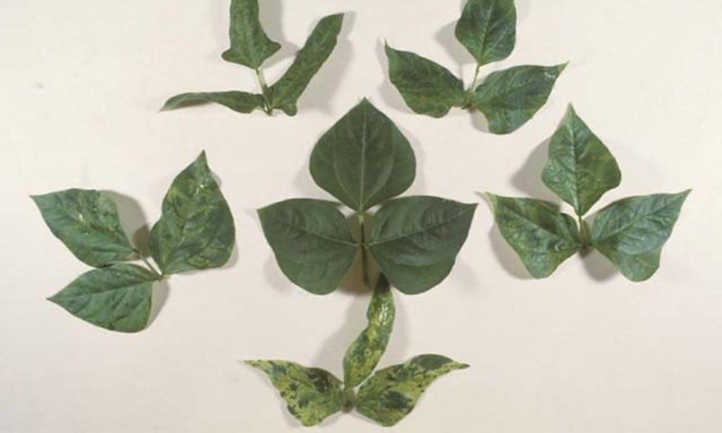
Apple chlorotic leaf spot virus causes a ringed brown spot on apples, pears, and stonefruit. It reduces crop vigor and causes damage to leaves. The virus that causes the disease – a trichovirus in the Betaflexiviridae family – is dispersed through contact with infected rootstock. There is no cure, so the best possible prevention for the viral disease is to ensure you’re purchasing disease-free rootstock.
Mosaic viruses that display dark brown spots are often in the latest stages of infection. There are over 150 viral pathogens that cause observed mosaic symptoms of yellowed mottling of leaves. As the virus replicates the yellow mottling causes leaf curl and browning. Soybean, other bean crops, tobacco, cucumber, and tomato are just a few of the many susceptible crops that can experience significant losses from these viruses. Leaf growth will become distorted and sometimes shoestringing of leaves may occur. There is no treatment for these viral symptoms, so preventing the virus is key. Pull all infected crops and destroy them to prevent dispersal to other crops. Grow resistant varieties and sanitize garden tools. Control weeds and aphids where the virus is sometimes harbored. Sanitize seeds with a 1:10 treatment of bleach diluted in water. Since mosaic viruses are so destructed, they should be reported to your local agricultural extension office.
Tobacco etch virus symptoms of yellow stippling are a precursor to brown spots on leaf matter. Its symptoms come from viruses in the genus Potyvirus and the family Potyviridae. It affects members of the Solanaceae family. While symptoms vary for each host, vein clearing, mottling, and necrotic lines are often seen. Leaves brown and fruit and the plants can become stunted. Aphids are the main vector for this infection. Control them and you’ll prevent the virus overall.
Tomato spotted wilt virus is another disease that develops brown lesions late in its infection stages. It starts with yellow rings which become necrotic as the virus replicates. Thrips are vectors for this virus and should be controlled to prevent its proliferation. Grow tomato varieties with resistance to the virus. If your tomatoes are infected, remove them and destroy them. Do not place new tomatoes near the area where the infection occurred.
Ringspot viruses are caused by viruses that create rings on fruit first, which become necrotic and brown as their quantity increases. It affects fruit of all kinds in a wide range. Reduce the frequency of the virus by practicing the proper timing of sowing seed and transplanting. If a field has been known to have ringspot infection present, do not sow seed again until a soil test shows the soil is free of the virus. Control the dispersal of the virus by only growing varieties and rootstock that is disease-free.
Pests That Cause Brown Spot
Thrips, aphids, fungus gnats, scale, leafhoppers, and spider mites are all common insect pests responsible for the development of brown spots in field crops and gardens. That’s because they’re often vectors for viral or fungal diseases that assist in the development of dispersed disease matter, whether that’s in the form of sucking on leaf matter or simply landing on leaves increasing a disease’s range. Management of these pests varies from insect to insect, but overall, reduce their presence in your garden by providing high-quality field and garden conditions to decrease a crop’s susceptibility to disease and pest attacks.
To be more specific, aphids, spider mites, and thrips are sapsuckers that may inject viral matter into leaf tissue as they feed. Leafhoppers simply land on a leaf and cause viral transfer in quick timing – often a matter of a couple of minutes. Gnat larvae can transfer fungal disease by carrying it to the roots where their adult bodies are formed. Management of these pests is best carried out through encouraging their natural predators and applying organic insecticides in the field, like neem oil, insecticidal soap, and sometimes pyrethrins and spinosad. Removal of tillage and debris from infested crops is important too. If there is a high incidence of these pests in your garden and management is difficult, it may be useful to enhance your pest management strategy by including chemical insecticides. This is the last resort, though, and should be included with appropriate organic and cultural measures.
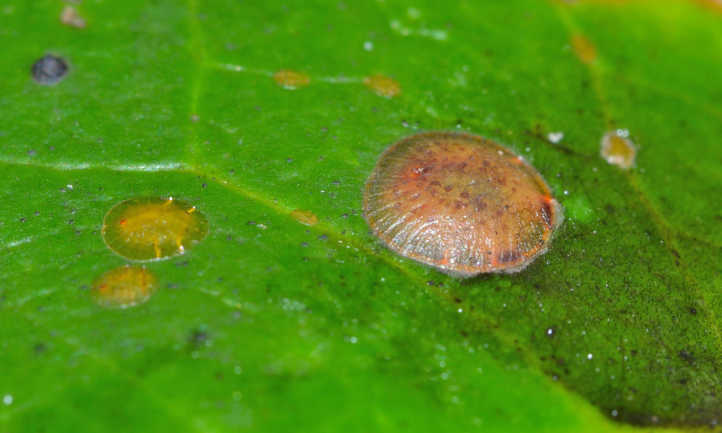
Conditions That Cause Brown Spot
The range of brown spots doesn’t stop at the development of spores on conidia, nor does it end with fungi or viruses. Sometimes the normal conditions for a plant just aren’t present, and brown spots appear on leaves through those conditions overall.
If you under-water, this can cause a yellow color and eventually browning leaves that struggle to absorb proper nutrients. Overexposure to light and heat can also cause leaf browning. Management of proper light and irrigation conditions is very important in this regard. Another issue that occurs is high salinity in water. This can create conditions where some varieties of houseplants or crops take on yellow to brown in color lower leaves.
If leaf-browning and lesions occur the culprit could be a lack of nutrients or nutrient burn from too much fertilizer. If the lower leaves of your plant are falling off, too much water and nutrients could be present. Remember not to overfertilize, water well in warm water, and provide adequate nutrients in the soil to keep the leaf color consistent, and to keep lower leaves on the stem.
Frequently Asked Questions
Q: How do you get rid of brown spots on leaves?
A: It depends on the cause of the browning. See the categories above to determine what the cause is, and go from there.
Q: Should I cut off leaves with brown spots?
A: Again, this depends. Some fungal conditions are treated by removing leaves that show signs of developing conidia or lesions that come from fungi. But other conditions require tissue remain attached for recovery.
Q: Can lawn recover from brown patch?
A: Yes. It’s best not to walk over the patch or mow as this will result in high dispersal of spores to other areas of the yard.
Q: Can leaf spot be cured?
A: The vast majority of leaf spots can be cured. However, all the viral pathogens mentioned here require the removal and disposal of the entire crop.

